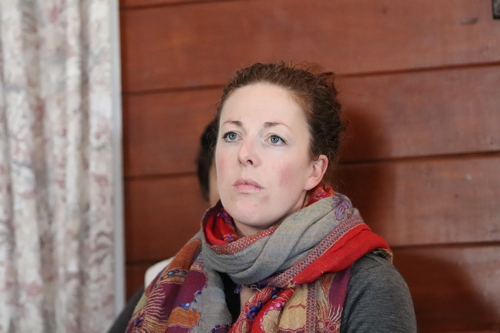New strategy lays out NRC commitment to climate action
28 Jul 2021, 1:45 PM
Ensuring the wellbeing of current and future generations, and Northland’s natural environment, by addressing the causes and impacts of climate change is the vision of Ngā Taumata o te Moana*, Northland Regional Council’s newly adopted strategy to tackle climate change.
The strategy lays out Northland Regional Council’s (NRC) commitment to climate action. It envisages a region that’s resilient in a changing climate, and transitions “proactively and equitably” to a thriving net-zero emissions society before 2050.
Councillor Amy Macdonald, Chair of council's Climate Change Working Party, says the strategy acknowledges the urgent need for change, and the significant role council plays in addressing climate change to protect current and future generations.
 Climate Change Working Party Chair Amy Macdonald listens to a presentation on global warming during a Te Taitokerau Māori and Council Working Party meeting at Whirinaki’s Moria Marae recently.
Climate Change Working Party Chair Amy Macdonald listens to a presentation on global warming during a Te Taitokerau Māori and Council Working Party meeting at Whirinaki’s Moria Marae recently.
“In Northland, the effects of climate change will increasingly disrupt our water, land, ecosystems, people and economy. The climate crisis is our generation’s biggest challenge, and this decade is crucial – we must respond by transforming how our society and economy operate.”
“Our society needs to reach net zero emissions by 2050, and we also need to adapt to the impacts of climate change and restore our valuable carbon-storing ecosystems.”
To achieve that, we must all take ownership of this issue and work together in partnership, “to support resilience and a transition that is tika (correct and fair)”.
Many of NRC’s existing activities – such as freshwater management, Civil Defence and flood protection – already address issues created by climate change. But Councillor Macdonald says NRC recognises it needs to work more collaboratively and in partnership with tangata whenua, communities and stakeholders to deliver a wider programme to target climate change initiatives, and in doing so embed climate responses more deliberately across the organisation.
Council is framing its response to the climate crisis in terms of three pou: adaptation, reducing emissions, and removing carbon.
Adaptation involves building the resilience of communities and natural systems so they can weather the current impacts, and the significant future effects, of climate change including drought, coastal hazards, sea level rise and flooding.
“This involves developing community adaptation plans for larger population centres and supporting smaller communities and hapū/marae to develop their own adaptation plans. We also intend to map vulnerable areas of Northland and invest in research to understand and plan for different climate scenarios.”
Councillor Macdonald says the council’s role as an environmental steward means it has a specific focus on how a changing climate threatens the region’s biosecurity, natural habitats and biodiversity.
“By supporting locally relevant research and monitoring, we establish knowledge to ensure we are well prepared to respond to climate risks and nurture the long-term health of our natural environment.”
Reducing emissions is a challenging issue for Northland. Overall, roughly 80 percent of the region’s emissions come mainly from agriculture and manufacturing; the balance come from transport, services and homes.
Northland faces an additional challenge in that its contribution to national emissions is disproportionate due to the presence of high-emitting industry, including the Marsden Pt oil refinery and Portland cement works.
Councillor Macdonald says council is already reducing emissions through electric vehicles and renewable energy but aims to significantly reduce the use of fossil fuels in its operations and infrastructure through further investments in zero-emissions technology, and by supporting the region to transition to a net-zero emissions economy.
“Council aims to take a leading role in helping reduce Te Taitokerau’s emissions, by supporting communities and businesses to adopt net-zero emissions practices, and by delivering high-quality public transport and other services.”
Councillor Macdonald says while emissions reductions are a priority, efforts are also needed to start cleaning up existing carbon pollution. Council will encourage activities that help remove carbon from the atmosphere by enhancing natural processes that capture and store carbon, such as growing trees and protecting wetlands, while achieving other benefits such as improved biodiversity.
“There is a huge opportunity to improve in this area, and we plan to bring an awareness of the carbon cycle to all our activities. We also plan to work with partners to support innovative carbon removal programmes across the region.”
“We are pushing to reach to a point where council’s end state is ‘climate positive’; where the balance of the atmospheric carbon we are able to permanently sequester exceeds our residual greenhouse gas emissions.”
While acknowledging the strategy was aspirational, she says the council intends to do everything in its power to ensure the goals are achieved.
“We have no choice. We owe it to ourselves, to our children and grandchildren and those generations still to come to leave the world in a better place than the one we inherited. Failure is really not an option.”
The 24-page strategy can be found at www.nrc.govt.nz/climatechange
*Note: The climate change strategy’s name was provided by Pita Tipene, Co-Chair of Te Taitokerau Māori and Council Working Party. The whakataukī (proverb) ‘Titiro atu ki ngã taumata o te moana’ was first uttered by the Ariki of Ngati Hine, Te Ruki Kawiti immediately after the battle of Ruapekapeka in Jan 1846 and literally means 'Look to the horizons of the ocean'. It encourages us to think strategically and maintain a global outlook while appreciating the ground upon which we stand.
